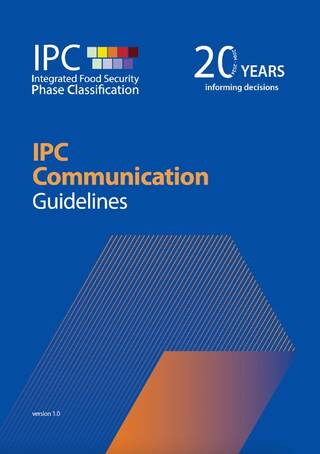IPC Communications Guidelines

Type and Objective of Product
Communication Guidance Product
With food and nutrition crises persisting – affecting millions of people in different parts of the world – demand for actionable information has never been higher. Effective communication of acute food insecurity and malnutrition information must clearly and succinctly describe the context, causes and outcomes. Based on the IPC Technical Manual Version 3.1, these guidelines are intended for individuals involved in communication, advocacy, media reporting, humanitarian response planning, funding, and/or reporting. Their purpose is to assist communicators in effectively informing non-specialist audiences about IPC findings in a manner that is accurate, informative, accessible, and empowering, aiming to achieve the following objectives:
- Knowledge: Clearly understand the IPC Acute Food Insecurity and Acute Malnutrition scales.
- Accuracy: Communicate a true representation of the IPC findings.
- Clarity: Communicate clearly, concisely and effectively to convey the urgency and scale of acute food insecurity and malnutrition.
- Consistency: Communicate IPC findings in a consistent language and voice across all platforms, channels and products.
- Empathy: Communicate while understanding and acknowledging that people are behind the figures.
Mandatory Content
These guidelines provide key communication considerations to facilitate conversations with different stakeholders, particularly members of the lay public who are not experts or qualified in food and nutrition security and greatly vary in age, interests, experiences and opinions. To accommodate these differences, the communication guidelines suggest simplified approaches to communicating complex acute food insecurity and malnutrition analyses. The guidelines outline:
- Technical description: Technical messages that describe the IPC phases.
- Interpretation: Simplified meaning of the technical description.
- Call to action: A communication term for any message designed to prompt an immediate response or action.
- The cost of inaction: The likely consequence that comes about from not acting.
Target Audience
The IPC Communications Guidelines is designed to meet the needs of three key audiences, including:
- Communications Officers: Organizations responsible for communicating findings and raising public awareness through strategic communication efforts.
- Journalists: Media representatives writing about the crisis.
- Donors: International donors supplying essential funding and resources to support humanitarian initiatives.
- Humanitarian Agencies: UN agencies, NGOs, and donors coordinating and executing humanitarian interventions.
Branding and Format
The IPC Communications Guidelines follow standardised branding to ensure consistency and credibility:
- Size: Standard A4 book format for easy use.
- Fonts: The primary and secondary font is Myriad Pro, a sans-serif typeface with a classic and fresh appearance that aligns with the IPC brand.
Log Information and Disclaimers
- Product Metadata Information: Publication date, data sources, and TWG contact details.
- Disclaimers:
- Standard Map Disclaimer: Apply the official IPC map disclaimer. See IPC Mapping Guidelines.
- Non-Endorsement Disclaimer: If the government does not endorse the analysis, include a disclaimer stating that the government has not yet endorsed the findings by the time of publication
Dissemination
IPC Communications Guidelines are used and distributed through two channels to maximise reach and accessibility including:
- Media Engagement Forums: Training for journalists and media professionals through briefings and press kits.
- Communications Workshops and Webinars: Training sessions for stakeholders to understand and apply the guidelines.
- Printed Materials: Printing and distribution of booklets.
- Online Platforms and E-learning Modules: Host guidelines on IPC websites and learning platforms.
- Email: Regularly update stakeholders with IPC communication best practices and case studies.